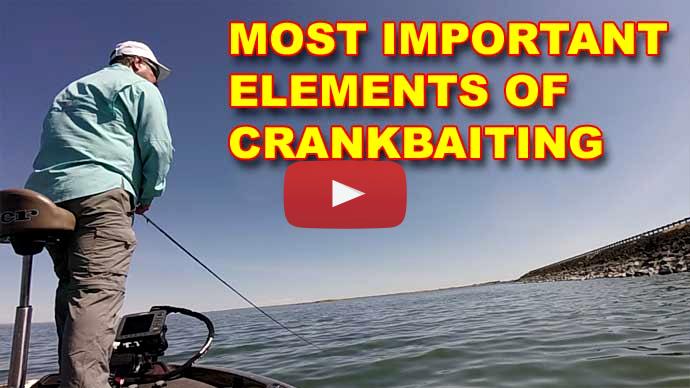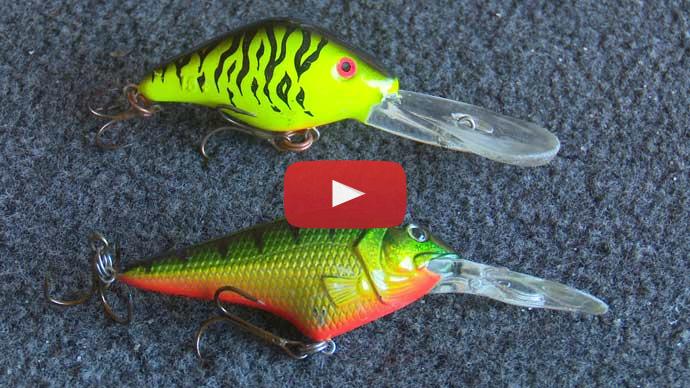All right, let's talk about the best setup for deep-diving crankbaits, starting with the rod. Now, there's basically two rods that I like to use. The one that I use, my bread and butter day in and day out, is a 7-foot-6, medium power, fast action rod. This one has a lot of parabolic action to it, and because of that, it allows you to throw out those crankbaits at further distances, which you need.
You need to get your crankbait way out there in order to allow it to reach its maximum depth. You can get it down there, and basically, a crankbait goes like this. It goes down and it comes back up. Well, the further out you can cast, when it gets down to its maximum diving, it stays down there longer before it starts to come back up when you're reeling it back up to you. So a long cast is essential. That parabolic bend in the rod is what's going to allow you to do that.
But also that give, that flex that it has is paramount. When a fish attacks your lure and you're bringing them back, those hooks don't have a lot of bite in it. I like to use longer shank hooks on my crankbaits, not those small shank ones. They don't have as much bite to it. But those fish, when they're fighting it, those are thin-wired hooks, and they can easily pull free if you've got a rod with a lot of backbone to it. So a medium power rod has that give and that parabolic action to give when the bass surges. It's going to keep that fish pinned and it won't allow them to rip those hooks free. So those are the characteristics I'm looking for in a rod.
Now that will cover most crankbaits that will dive down to about 12, 15 feet deep. When you're looking for deeper than that, then it depends on the bait. There are some small baits out there that can get down to 20 feet or more, like the Mann's 20. Mann's 20+ works really well and you can still throw it with that rod. But if you're fishing a heavier crankbait, Berkley has a few of these out there that'll get you down like a Dredger series. They'll get down there past 25 feet and they're a bigger bait, a bigger profile, they got bigger hooks on them.
That's going to up on the rod to a medium heavy rod. These baits typically will work your forearms to death. They're hard to work and it takes a little bit of physical strength. More importantly is when that bass hits and you're fighting them, because it's a larger bait and because the hooks are bigger, you can use that heavier power rod to keep the fish pinned and it gives the bass less chance of them from throwing the lure. So that is definitely the two different rods that I'll use.
Let's talk about reel. Reel is really simple. Regardless of whether I'm fishing a crankbait that dives down to 10 feet deep or one that dives down to 30, reel is basically the same, is a slow gear ratio, something in the 5.2 to 6.1 range. That's what you want when you're crankbaiting. You want a slower-moving bait. You can speed it up simply by reeling faster.
The problem is it's hard to find some of those reels out there. There's not a ton of reels right now that have a gear ratio under 6.2 to 1. So alternatively, rather than searching near and far for a reel like that, you can also just slow down when you are working a lure. Just be sure that you don't start thinking about what you got to do when you get home or whatever. Next thing you know, you're cranking at a normal speed. You've got to pay attention to that speed and slow it down.
A lot of times also, the stop-and-go retrieve works really well. Or another way to do it, if you're not too sure about your cadence, is to just pull on the rod tip. Just pull along at a slower speed. Stop, reel up that slack, and pull along slow. That's another way to control how fast your bait comes back to you.
Let's talk about line. Line is also a simple choice. Line here for me is going to be fluorocarbon. Fluorocarbon always. I like to use the Seaguar Tatsu 12-pound fluorocarbon line for several reasons. Fluorocarbon, first of all, is very characteristic of it is that it sinks, so it allows you to get that bait down to its diving depth. Braid by contrast is buoyant, and it will inhibit the action and that ability for the bait to get down to its maximum depth. That's just the characteristic of braid. Plus, a lot of times when you're casting a crankbait around, you're throwing it around rocks, rip raps, stumps, other things that the line will rub up against. And believe it or not, fluorocarbon is more abrasion-resistant than braid. So fluorocarbon is going to do a better job.
With any line, you always have to keep checking it, especially if you are rubbing it against objects. So it's not bulletproof. Make sure you're checking the line all the time. So if you're casting a lot where you feel that line being draped over rocks and rip rap and other things and around dock pylons and stuff, make sure you check it periodically.
The 12-pound I like to use because it's really thin diameter and it has less resistance in the water, allows you to get that bait, again, down to its maximum diving depth. Plus, because it doesn't have much resistance, the bait is allowed to move freely and it looks more natural that way. So fluorocarbon, 12-pound fluorocarbon, all the way for me when it comes to crankbaiting.
Let's talk a little bit about the baits themselves. Now deep diving crankbaits, there's a lot out there. Norman's DD+, the Mann's 20+, Berkley makes the Dredger. I mean, I can go on and on. There are so many out there. They're all really good baits to use, but the key thing with using them is both where and how you throw them and color. One is where and how you throw them. Again, you want them to be hitting things, knocking, bouncing off of objects. Typically, you're fishing real deep here, obviously, so long tapering points, drop-offs, ledges, humps. If you can get it down to where the rocks are and let it deflect off that rock, that usually is what it lets it to bite. So make sure you get it down to where it's bouncing off of things.
As far as color is concerned, the clearer the water, the more natural colors I want. So clearer water, generally, to me, means green colors or natural perch colors, shad colors, that kind of stuff that really does imitate the forage species in the lake. If you got some dingier water, a little bit muddier water, then I tend to go with a little more flashier colors like your fire tigers, anything with chartreuse in it. Your chartreuse and black works really well. It's kind of universal, works all around the country as long as you've got some dingy water out there.
If the water's super clear and you got sunny days, then I'll go for translucent colors. You can actually kind of see through the bait. Those look really well in those clear water situations. I know it's not appealing to us humans, but if you can find baits that are in the muted kind of colors, the kind of washed out colors, there are manufacturers that make them like that, those tend to work really well. Back in the day when you can do this, we used to take the crankbaits and put them on the dash of our truck and let it sit in the sun for a few days and let it fade the color. And we found you catch a lot more bass that way.
Well, today's paint is a lot different. It's a lot more durable and it's really hard to get it to fade. But the manufacturers, some of them are coming out with faded, muted colors. They don't look that appealing on the shelf, but I promise you guys, find those colors and throw them. You'd be surprised. Bone color also can work wonders. Again, it's a color that's off. It's underrated. It's a color a lot of guys don't throw, but I have had great days throwing bone and white colored crankbaits, regardless of water clarity or wind or anything like that.
The windier it is, the less light penetration. You can go more to those brighter colors. But that's basically it. You don't have to go too hogwild with a bunch of different colors because you're fishing deeper and there's less light penetration in deeper water anyway. So you don't need to have every color under the sun, but those are the basics. And with everything I just told you, you ought to be able to catch a lot of fish with deep-diving crankbaits this summer. Hope that helps. For more tips and tricks like this, visit Bassresource.com.



